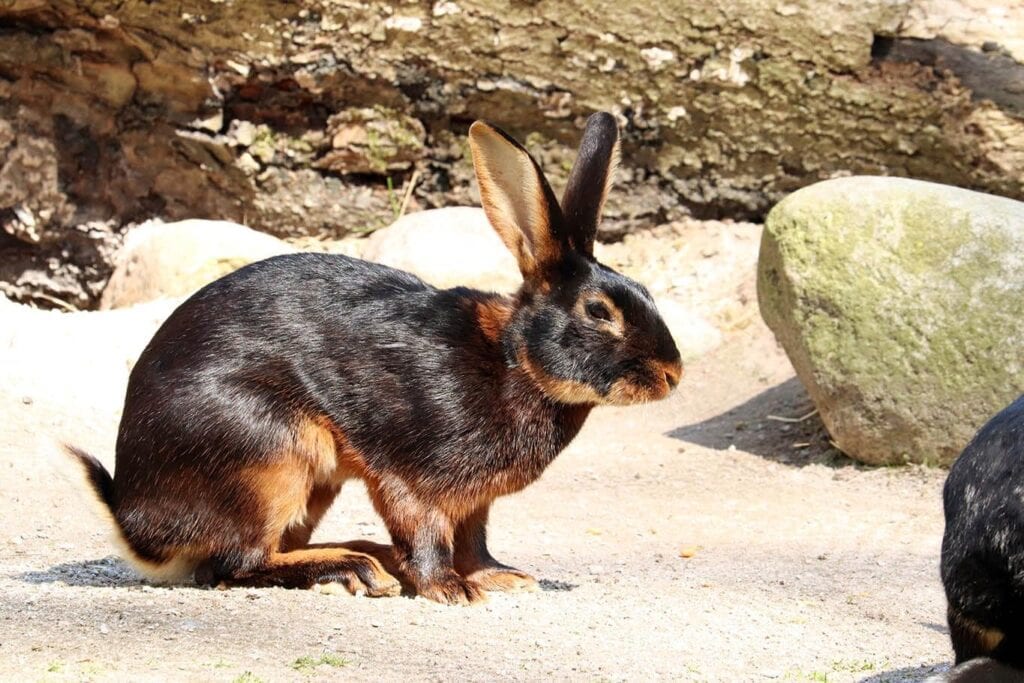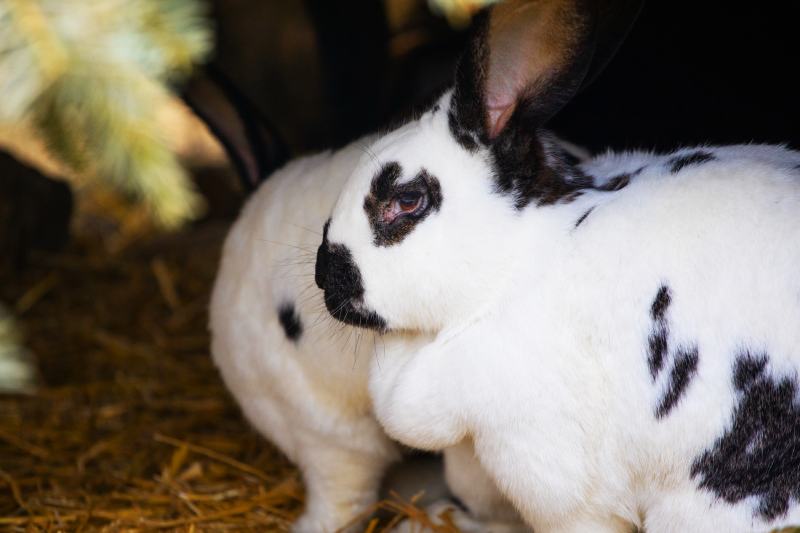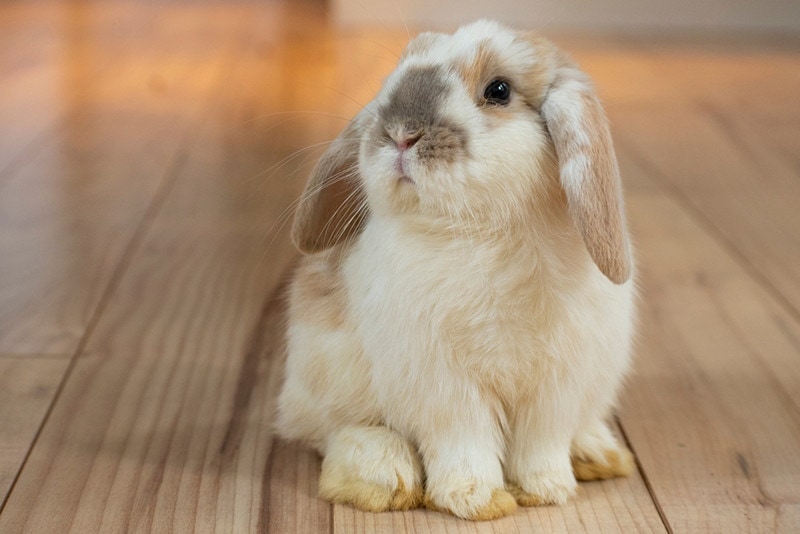Belgian Hare: Pictures, Care Guide, Lifespan & Traits
Updated on

The Belgian Hare is a domesticated breed that somewhat resembles the wild European hare. Despite its name, this breed is technically a rabbit—not a hare. As you might expect, they have a wiry frame, powerful legs, arched back, and tall ears.
| Size: | Large |
| Weight: | 6–9 pounds |
| Lifespan: | 7–10 years |
| Similar Breeds: | English Spot, Checkered Giant |
| Suitable for: | Experienced rabbit owners with plenty of room |
| Temperament: | Intelligent, active, friendly, curious |
Their short, glossy coat is usually a bright “rust” color. Black markings are very common, too.
These rabbits are known for being intelligent and active. They require quite a bit more work than other breeds due to their larger size and engaging personality. They’re a curious breed that needs quite a bit of entertainment.
Belgian Hare Breed Characteristics
 How Much Do These Rabbits Cost?
How Much Do These Rabbits Cost?
The Belgian Hare can vary in price depending on the breeder and availability. If you live in an area where these rabbits are rare, you can expect to pay a higher price.
Generally, they cost between $150 and $500. However, some purebred Belgian Hares can cost up to $1,000 or more. That’s just the cost of the rabbit—not counting all the things you have to buy for the rabbit. Because these rabbits are larger, they often need larger hutches and other equipment, which can add up quickly.

Temperament & Intelligence of the Belgian Hare
These hares are extremely energetic and agile, requiring lots of time and space to burn off their energy. They need exercise much more than other breeds. They love to run and jump, which has earned them the nickname “rabbit racehorse.” This breed is known for going and never stopping.
They aren’t a breed you spend much time cuddling.
They’re also rather smart. They’ll learn their name and respond to it. They can even learn a few other commands, too—especially when food is involved. They can be taught to walk on leashes if they have the patience. Like most rabbits, they can also be litter-trained.
Typically, these rabbits are friendly when socialized correctly. They bond with their owners and other rabbits readily. They enjoy the attention and will often seek it out. However, they can also be independent and occasionally stubborn.
With that said, these rabbits can be skittish. They’re easily startled, which is made even more dramatic by their energetic nature and they require a calm environment to function. Furthermore, this breed kicks on instinct when startled or threatened. Because of their strong legs, this is something to keep in mind.
Do These Rabbits Make Good Pets? 👪
The Belgian Hare can make a good pet for the right person. Many people love their intelligent and friendly personalities. They’re smart enough to learn basic commands and respond to their name. Plus, they’re friendly and curious. They enjoy interaction, which isn’t something you can say about all rabbit breeds.
However, they’re easily scared by noise and movement. They’re also extremely energetic, requiring more room than other rabbits. Those looking for a rabbit to cuddle won’t be happy with this breed, and they aren’t suitable for children because they tend to kick a lot.
This breed also isn’t the hardiest. They’re sensitive to high temperatures and humidity.
Does This Rabbit Get Along with Other Pets?
The Belgian Hare isn’t always the best choice for those with other pets. They scare easily, which makes them incompatible with most other animals. They’re prey animals through and through. Therefore, other animals often see them as a snack. When threatened, these rabbits won’t do well. They can easily become so anxious that they make themselves sick. They aren’t recommended for homes with dogs, cats, and similar animals.
However, they may get along with other hares of a similar temperament, especially if socialized at a young age. Many will even bond closely with other rabbits and enjoy their company. They’re rather friendly, after all.
With that said, some Belgian Hares simply won’t get along with other rabbits for one reason or another. There is individual variation within the breed.
 Things to Know When Owning a Belgian Hare
Things to Know When Owning a Belgian Hare
Food & Diet Requirements 🥕
Belgian Hares need a similar diet to other domestic rabbits. Their main source of calories should be hay, as it provides fiber and keeps their teeth worn down. Hay should be provided at all times, as well as fresh water. They’ll also need pellets, which should be formulated for rabbits specifically. These provide some extra nutrients, but they shouldn’t be fed in excess because they can cause obesity. Instead, you should carefully follow the directions on the bag for feeding.
On top of hay and pellets, you should provide fresh vegetables (and occasionally fruit). These should only be provided in moderation and after 4 months old. Otherwise, your rabbit may develop digestive discomfort.
Not all veggies are made equal, either. You should choose leafy greens or low-sugar fruits like lettuce, parsley, cilantro, broccoli, celery, apple, banana, and berries. Do not give rabbits cauliflower, corn, potatoes, onions, garlic, chocolate, or bread as these are unsafe foods.
Habitat & Hutch Requirements 🏠
Because these rabbits are so large, they need a large habitat. They’re usually kept in wooden hutches with wood shavings and straw bedding. The bottom of their hutch must be solid to prevent foot injuries, and the top should be at least 24 inches high. The floor area must be at least 24 by 60 inches—large or pregnant rabbits may need more.
Belgian Hares are sensitive to humidity and heat, so keep that in mind when designing their living space. They can suffer from heat stress easily. Ensure they have sufficient ventilation and shade in the summer, as well as plenty of bedding in the winter.
These hares are more intelligent than other breeds. Therefore, you must provide them with enrichment to keep them happy. Toys and other activities can keep their mind stimulated. Furthermore, chew toys are necessary to prevent their teeth from overgrowing.
Belgian Hares benefit from some privacy, as they can be skittish.
Exercise & Sleeping Needs 🐇
Belgian Hares need plenty of exercise, as they are an active and agile breed. You should provide them with at least an hour of exercise a day in a fenced-in area or on a leash. As prey animals, they must be supervised when not in their hutch. You should also provide some exercise equipment within their hutch. Tunnels, ramps, balls, and chew toys work well—provide a variety to prevent boredom.
These rabbits are crepuscular, which means they’re most active at dawn and dusk—just like other rabbits. They sleep for about 8 hours a day, usually during the daylight hours. Be sure your rabbit has a cozy place they can sleep, with plenty of insulation. Because they’re easily stressed, providing them with a dark place they can “hide” is important.
Training 🥎
This breed is rather intelligent, so they can be trained and these rabbits do benefit from some training. It can help them stay stimulated and make them easier to care for.
There are many potential tasks you can train them to do. One of the most helpful is responding to their name. They will learn to come to you for food when you say their name with enough repetition. Start at a close distance and gradually get further away. This command can make them much more controllable and easier to catch.
You can also train them to walk on a leash. Because this breed needs lots of exercise, walking on a leash can be extremely helpful. Start by letting them get used to the harness and leash indoors, and then introduce them to the outdoors. Remember, these rabbits scare very easily, so taking them to the park or around lots of people isn’t a good idea.
Grooming ✂️
Belgian Hares have a short coat that doesn’t require much grooming. They don’t need to be brushed more than weekly and a short brushing session can help remove loose hairs and dirt. You can’t bathe a rabbit easily, so brushing is really the best way to keep them clean.
These rabbits shed heavily twice a year as the seasons change, similar to a dog. When this occurs, you may need to brush them twice a week. If you need to clean your rabbit, you can use a damp cloth. Avoid getting them very wet, as this can cause health problems.
Because these rabbits have such powerful legs, sharp nails can cause significant injuries to themselves and others. Therefore, you’ll need to keep their nails trimmed short. Use a pair of nail clippers designed for rabbits to trim their nails about every month or so.
Lifespan and Health Conditions 🏥
These rabbits aren’t the hardiest breed out there. They’re more prone to diseases of all sorts and more sensitive to the weather. Their average lifespan is between 7 to 11 years. Smaller hares tend to live longer than oversized ones.
This breed isn’t prone to any specific genetic diseases. However, they’re more sensitive to common rabbit diseases, like ear mites, flystrike, snuffles, and dental problems.
- Ear mites
- Dental problems
- Flystrike
- Snuffles
Male vs. Female
This breed doesn’t have any significant differences between genders. The only real difference is their reproduction organs and breeding behavior, which is common amongst all rabbits.
The 3 Little-Known Facts About the Belgian Hare
1. They aren’t actually a hare.
Despite their name, the Belgian Hare isn’t really a hare. They received that name because they resemble European hares. However, they’re really a rabbit that was selectively bred to look like a hare.
2. They were originally bred for meat.
This breed wasn’t originally developed as a pet rabbit. Instead, they were developed in Belgium in the early 18th century for meat.
3. Belgian Hares are some of the most intelligent rabbits.
This breed is one of the most intelligent breeds of domestic rabbits. They can be trained to respond to their name and walk on a leash. However, their intelligence also makes them more skittish than other rabbits.
Final Thoughts
Belgian Hares are one of the more energetic and intelligent breeds of rabbits. They’re great for those looking for a very involved pet rabbit. They’re fun companions that work best for active families. However, if you’re looking for a rabbit to cuddle, Belgian Hares aren’t necessarily the best option.
With that said, these rabbits require a lot of exercise, which can be a bit too much for some owners. Their alert nature makes them skittish, and they aren’t the hardiest breed.
Featured Image Credit to: Cassidy-Te, Shutterstock
 How Much Do These Rabbits Cost?
How Much Do These Rabbits Cost?










